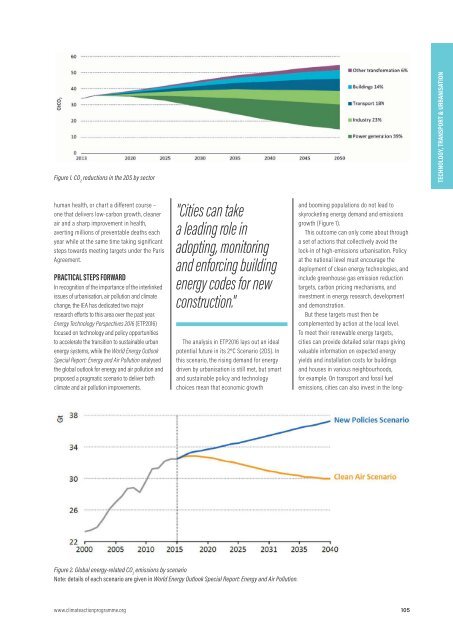Climate Action 2016-2017
Create successful ePaper yourself
Turn your PDF publications into a flip-book with our unique Google optimized e-Paper software.
Figure 1. CO 2<br />
reductions in the 2DS by sector<br />
TECHNOLOGY, TRANSPORT & URBANISATION<br />
human health, or chart a different course –<br />
one that delivers low-carbon growth, cleaner<br />
air and a sharp improvement in health,<br />
averting millions of preventable deaths each<br />
year while at the same time taking significant<br />
steps towards meeting targets under the Paris<br />
Agreement.<br />
PRACTICAL STEPS FORWARD<br />
In recognition of the importance of the interlinked<br />
issues of urbanisation, air pollution and climate<br />
change, the IEA has dedicated two major<br />
research efforts to this area over the past year.<br />
Energy Technology Perspectives <strong>2016</strong> (ETP<strong>2016</strong>)<br />
focused on technology and policy opportunities<br />
to accelerate the transition to sustainable urban<br />
energy systems, while the World Energy Outlook<br />
Special Report: Energy and Air Pollution analysed<br />
the global outlook for energy and air pollution and<br />
proposed a pragmatic scenario to deliver both<br />
climate and air pollution improvements.<br />
"Cities can take<br />
a leading role in<br />
adopting, monitoring<br />
and enforcing building<br />
energy codes for new<br />
construction."<br />
The analysis in ETP<strong>2016</strong> lays out an ideal<br />
potential future in its 2°C Scenario (2DS). In<br />
this scenario, the rising demand for energy<br />
driven by urbanisation is still met, but smart<br />
and sustainable policy and technology<br />
choices mean that economic growth<br />
and booming populations do not lead to<br />
skyrocketing energy demand and emissions<br />
growth (Figure 1).<br />
This outcome can only come about through<br />
a set of actions that collectively avoid the<br />
lock-in of high-emissions urbanisation. Policy<br />
at the national level must encourage the<br />
deployment of clean energy technologies, and<br />
include greenhouse gas emission reduction<br />
targets, carbon pricing mechanisms, and<br />
investment in energy research, development<br />
and demonstration.<br />
But these targets must then be<br />
complemented by action at the local level.<br />
To meet their renewable energy targets,<br />
cities can provide detailed solar maps giving<br />
valuable information on expected energy<br />
yields and installation costs for buildings<br />
and houses in various neighbourhoods,<br />
for example. On transport and fossil fuel<br />
emissions, cities can also invest in the long-<br />
Figure 2. Global energy-related CO 2<br />
emissions by scenario<br />
Note: details of each scenario are given in World Energy Outlook Special Report: Energy and Air Pollution.<br />
www.climateactionprogramme.org 105












